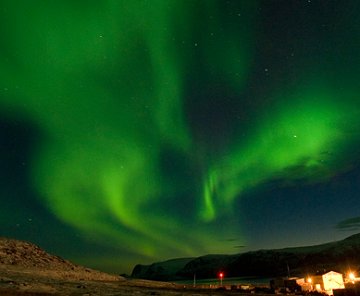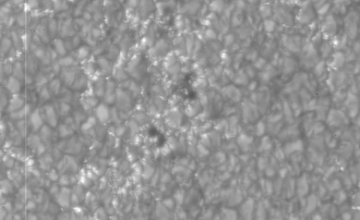 Where's Saturn? Is that a UFO--or the ISS? What's the name of that star? Get the answers from mySKY--a fun new astronomy helper from Meade. . Where's Saturn? Is that a UFO--or the ISS? What's the name of that star? Get the answers from mySKY--a fun new astronomy helper from Meade. . PROMINENCE ALERT: Got a solar telescope? Point it at the sun. Two large and active prominences have jumped up and are putting on a good show for onlookers: image. more images: from Maxim Usatov of Dniepropetrovsk, Ukraine; from Pascal Paquereau of Mouzeuil-Saint-Martin, Vendée, France. AURORA BURST: Last night, for no apparent reason, the sky over Baffin Island, Canada, erupted in green. "I had just come back from walking my dog when the night sky suddenly burst into light," reports Claus Vogel. "The display was dazzling." He grabbed his Nikon D200 and snapped this photo: 
Researchers call this kind of outburst an "auroral substorm." First recognized in the early 1960s by a young Japanese physicist named Shun-ichi Akasofu, auroral substorms have been studied for almost 50 years, yet to this day they are neither predictable nor fully understood. To solve the mystery, NASA has deployed a swarm of five spacecraft named THEMIS dedicated to the study of substorms. The probes are gathering data now--indeed, they may have observed the Baffin Island outburst pictured above--and mission scientists are reportedly learning a lot. We await the answers and, meanwhile, enjoy the show. September 2007 Aurora Gallery
[August 2007 Aurora Gallery] [Aurora Alerts] MICRO-SUNSPOT: Sunspots can grow so big they dwarf the planet Jupiter. But have you ever wondered, how small can they shrink? Yesterday, Japan's Hinode spacecraft photographed dwindling sunspot 971 revealing two dark cores each smaller than the United States: 
Technically, these are called pores--sunspots so small they do not even contribute to the sunspot number. (The sunspot number when Hinode took the picture was officially zero.) With its sub-arcsecond resolution (0.2"), Hinode's solar telescope is powerful enough to see these small features on a routine basis. The bumpy lumps surrounding the pores are called granules, They are California-sized blobs of sun rising and falling like water boiling on a hot stove. Indeed, the surface of the sun is boiling because it sits on top of a 15-million degree nuclear furnace. Conventional wisdom says sunspots never shrink any smaller than granules. Is this true? Hinode is just beginning to explore the sun in high resolution. Whether conventional wisdom survives the scrutiny remains to be seen. | 
